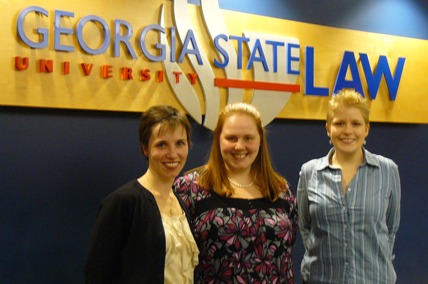College Site | Development | TOC - Department Dev Sites | CLHS TOC | Center for Law, Health & Society | News and Events | Center News | Collaboration Between Law and Medical Students Benefits Teenager with a Disability Collaboration Between Law and Medical Students Benefits Teenager with a Disability
April 7, 2011
ATLANTA -- Second-year law students Rachel Ashe and Caitlin Herndon were reminded of the importance of a partnership between the medical and legal professions as they worked on a HeLP Legal Services Clinic case recently.
 Their client was a high school student with cerebral palsy, a condition that affects brain and nervous system functioning and can cause, among other things, muscle tightening, muscle weakness and the loss of muscle movement, intellectual disabilities, speech problems, and hearing and vision problems. The two HeLP Clinic students were seeking to have the teenager's school district reevaluate the student's Individualized Education Plan (IEP).
Their client was a high school student with cerebral palsy, a condition that affects brain and nervous system functioning and can cause, among other things, muscle tightening, muscle weakness and the loss of muscle movement, intellectual disabilities, speech problems, and hearing and vision problems. The two HeLP Clinic students were seeking to have the teenager's school district reevaluate the student's Individualized Education Plan (IEP).
Under federal law, a student with a disability is entitled to a free appropriate public education. The IEP is the primary vehicle by which that free appropriate public education is provided. It is a written document that identifies the strengths and weaknesses of such students to address their needs in order to make progress in school. It contains goals and objectives for students with disabilities to work towards as well as outlines any services they need in school.
A child's guardians, teachers, and other specialists such as speech therapists meet to create or revise the IEP. "The special education system is complex, involving three or more layers of federal and state laws and regulations," according to Emily F. Suski, Clinical Supervising Attorney with the HeLP Clinic and the law students' supervisor. "Parents often have difficulty navigating the system, understanding it, and advocating for their children when they disagree with the school about what the student needs to make progress in school. That's where the Clinic students can step in and help to navigate the system and advocate for the child."
Ashe and Herndon's client had not made progress on his IEP goals in nearly two years and did not have sufficient services in his IEP to help him progress. "His parent did not understand the special education system, her rights, or her son's rights," said Ashe. "She needed assistance understanding these rights and enforcing them in the IEP meeting."
Over the course of several weeks, Ashe and Herndon and two fourth-year medical students from Morehouse School of Medicine, Curtis Jamison and Tiffany Gartrell, prepared to advocate for a plan that would meet the student's needs. In preparation, they visited his developmental pediatrician to discuss his potential and capabilities.
During the IEP meeting in March, Jamison explained the ramifications of cerebral palsy on the learning process. School staff and administrators asked him to explain what happens when children with cerebral palsy lose a skill they once had (for example, a child who could once write his name but can no longer do so). Jamison explained that people with cerebral palsy lose motor skills more quickly than people without cerebral palsy. While they can recover at least some of the lost skills, it takes them longer to do so than people without cerebral palsy.
"Our client had lost the ability to count to 25 and to write his name," said Herndon. "His mother wanted him to relearn these skills, which he once had."
Jamison's specialized knowledge and advocacy proved crucial to obtaining academic goals directed at helping the student relearn these skills. "Curtis's response was extremely valuable to the determination of the student's educational plan," said Herndon.
"It was one factor that seemed to encourage the school district to offer extended school year services to the student to help maintain his current abilities as well as any abilities he gains between now and the end of the school year," agreed Ashe. "With extended services, he will get services over school breaks."
"As a result of this meeting, the teenager has more realistic, specific, and measurable goals on his IEP than he has had in years," said Suski. He also will receive an additional 30 minutes of individualized speech therapy per week, for a total of 1.5 hours per week. He will also be provided with a new computerized communication device, which will enable him to more effectively communicate with the school students and staff.
"The HeLP Clinic strongly encourages interdisciplinary collaboration between law students and medical students," said Suski. "Students get to see how, by working together in an interdisciplinary team, they can benefit their clients and patients in ways they might not have been able to do as successfully if they had worked on a case with only the skills from their own professional background."